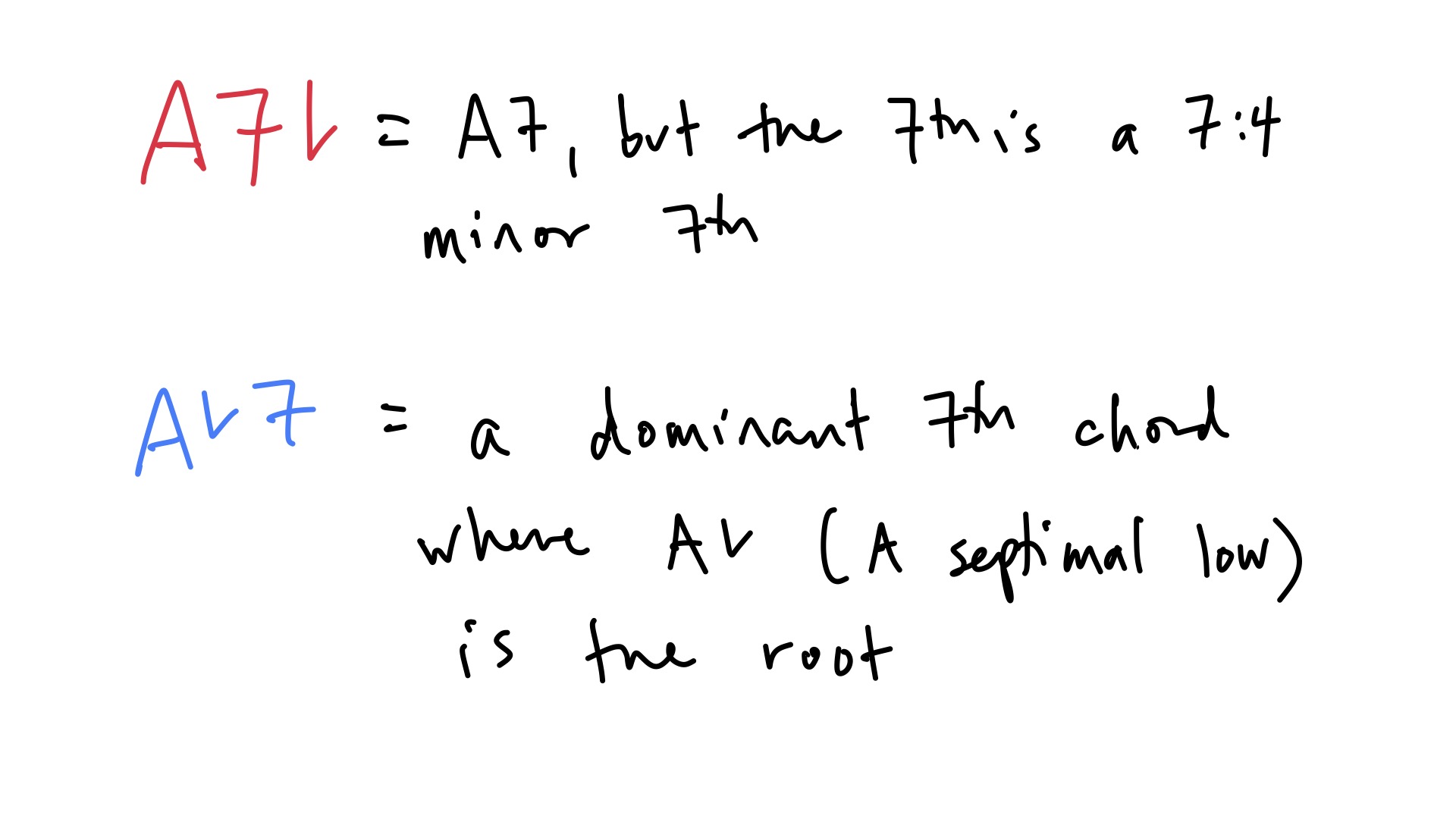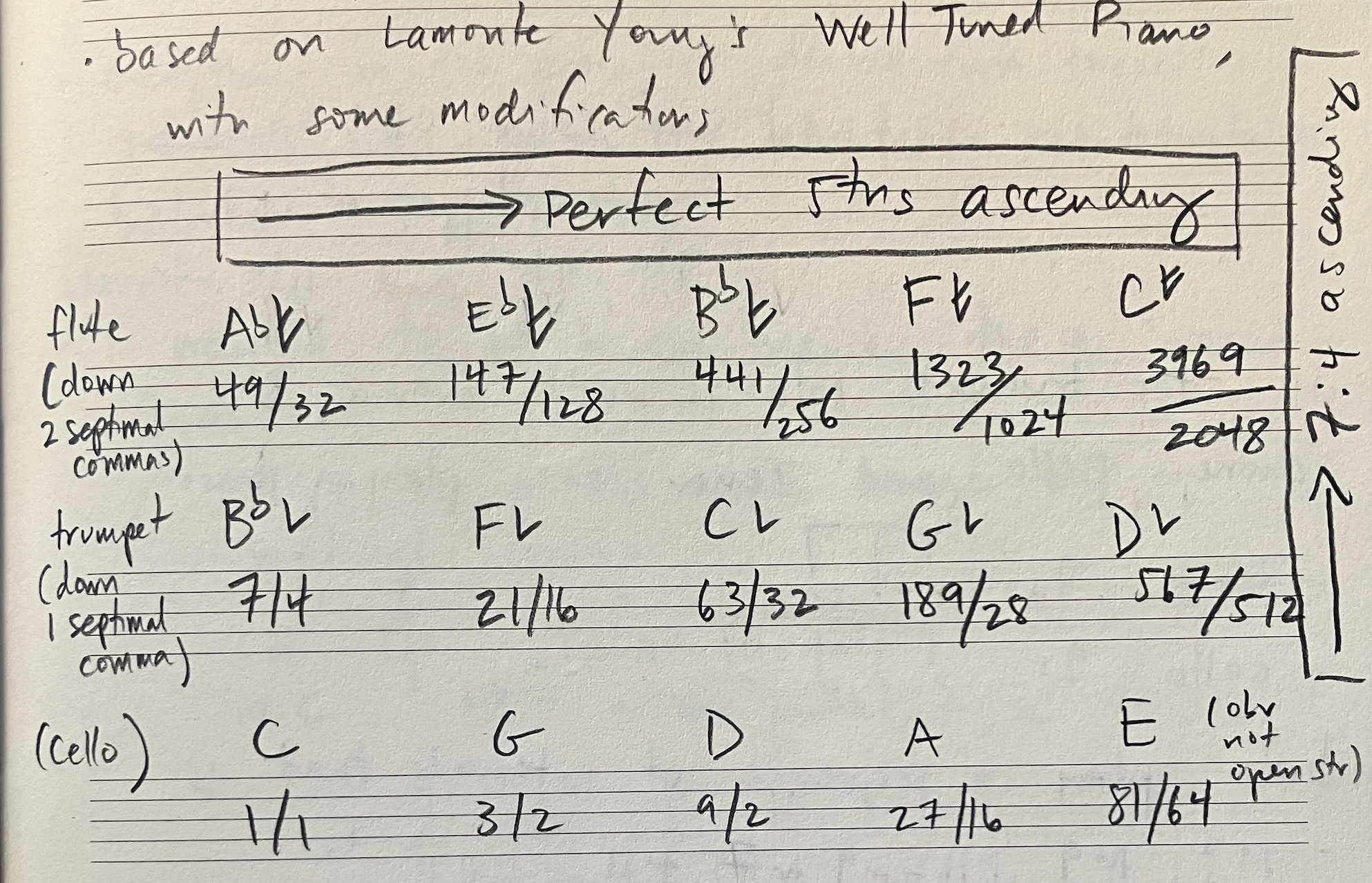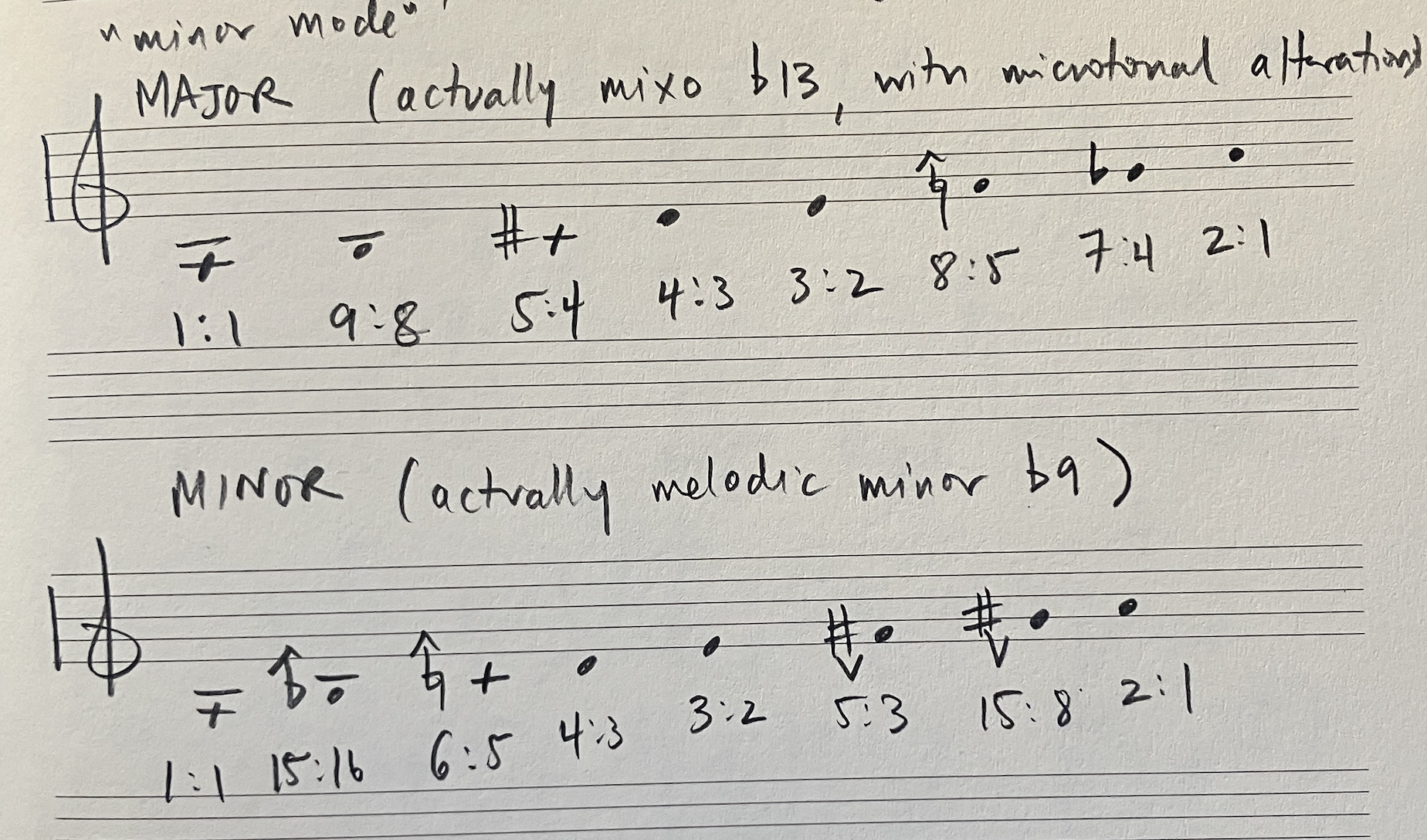shimmer wince secret info
hi there. for those few who might be interested, i wanted to collate some thoughts and information on the tuning systems i used on “shimmer wince”
to purchase scores, please go here:
shimmer wince scores
background
as i got to know the just intonation (ie “ji”) world a little better, i realized my priorities with using it were:
i wanted to use it as tool rather than an overarching/all-encompassing system, to use it in tandem with equal temperament and exploit those interesting clashes between the two worlds
i wanted to shift fundamentals as often as i felt like it
i wanted to write rhythmically active music
**note - i am assuming a basic knowledge of ji throughout. for a primer, check out kyle gann's site
also,
i felt like not much had been done that trusted woodwinds enough to find their way to specific ji notes without a reference pitch, and i believed that woodwinds were flexible enough to do anything as long as it was hear-able.
on that note, i wasn’t interested in finding alternate fingerings for every specific pitch. rather, i wanted to be able to train my ears to hear where to place each pitch correctly. i play everything on this album through a combination of quarter-tone fingerings and embouchure adjustments, and i think between these two, it’s possible to get basically every note that’s out there.
i was only interested in writing pitches within the ji system that could be reliably heard by performers in the room, and, more specifically, that i as the bandleader could nail and teach to the band. so, i didn't go into the stratosphere of the overtone series (yet!). i didn't really get beyond tridecimal (ie, 13th partial) harmony, and even that is used quite sparingly.
i didn’t start the music with the synth. i wanted to use the synth as reinforcement rather than a way of reaching complex upper partials that might be theoretically out of reach for people playing acoustic instruments with flexible intonation without a reference pitch.
something that i found challenging in composing with this type of microtonality is that even to begin the process of composition, ie, the playing around with ideas, you need to at least figure out how to HEAR what you’re working with. for me this meant a combination of various technological tools, including:
pure data
ji toolkit
marc sabat’s website
a max patch made for me by my friend weston olencki
pianoteq
notation
i am using a simplified helmholtz-ellis accidental system. simplified because for my purposes, legibility was more important to me than enharmonic accuracy. for me, it’s easier to read B quarter flat as opposed to A three-quarters sharp. in the same way, it’s easier to read a single lowered septimal comma rather than a raised double septimal comma. i occasionally used an accidental with an arrow for 5-limit harmony, but in some cases i omitted it as i felt that those of us with flexible pitch will actually tune our major thirds correctly by ear. i rounded undecimals and tridecimals to the nearest quarter-tone for the purposes of ease of notation. often, especially in my part, i wrote a ratio above the pitch, so that tuning would be easier.

synthesizer
throughout, the synthesizer is split into two instruments, more or less, with the left hand being an equal tempered bass instrument, and the right hand being an infinitely malleable playground of just intonation. all of the referenced tuning patches in the scores therefore only affect the right hand. (this made for some interesting gymnastics, especially in squirmy, with its quasi-tonal chord progression, where i had to draw on notes from both the “synth bass” and the “right hand synth” in order to create complete chords)
also note that there are often two synthesizer lines in the scores - one is sounding pitches, the other is what i gave elias, ie the “tablature version”, where he just saw the equal tempered notes he was to play on the synthesizer
chord symbols
i came up with a system for chord symbols for this piece that i felt would give people a jumping-off place for improvisation.

Wince was a little more complicated, as the thirds of the chord were either 9:7 or 9:11, with a cycle of either the major 7th, minor 7th, major 9th, or minor 9th creating the 3rd voice in the chord. So the cycle for the tenor solo looks like the following – the type of third is indicated by the ratio next to each bass note, and the 3rd note in the chord is the 7th or 9th.

the pieces
wince
this piece was the most difficult to write on the album, and, as is usually the case with the pieces that are the most frustrating, actually became my favorite by the time i’d figured out what it was...
it comes from an interest in polyrhythms, in this case 7:9:11
the basic harmony is 4 diads, two of them are 9:7s (big major 3rds) and 2 of them are 9:11s (neutral 3rds, in between major and minor)

i wanted to write a lyrical melody that could soar on top of those chords
and! i wanted to be able to play some semblance of the chords on the saxophone – this became the 16th note hocket line
7, 9, and 11 are the rhythmic basis of the whole piece. not in terms of tuplets, but in terms of cycles of 16th notes - adam’s solo is over “7 vs 9”, the middle section divides a bar of 4/4 into 7 16th notes + 9 16th notes (plus the occasional measure of 11/16), and my solo is over “9 vs 11”
shimmer
this piece came out relatively quickly, but only after i’d really been struggling to figure out what tuning system to use
i wanted to use “scordatura” for flute and trumpet, but to leave cello in normal tuning.
(side note: actually that was something i held myself to for this whole collection of music, and i think mariel really appreciated it? i didn’t want to achieve anything through scordatura on the cello. i know it’s hard for them, it means re-tuning mid-set, their instrument vibrates differently...and it was a good way of limiting my possibilities as a composer!)
anyway, so cello has open strings in equal temperament, C, G, D, A.
trumpet is tuned 7:4 above that (or, a septimal comma lower than A=440). bass flute is tuned a 7:4 above the trumpet (or 2 septimal commas lower than A=440).
this piece follows some of the basics of lamonte young’s well-tempered piano. the ratios are as follows:

the tuning system for the synth covers almost all of these pitches.
this tuning system creates a lot of really beautiful and resonant intervals – there are lots of 7:6 minor 3rds for example, and a lot of nice “very close” microtonality that i really dig.
periodicity 1 and periodicity 2
these pieces aren’t really using any sort of JI system, though there is some microtonality and some ji at play in a less systematic way.
they use a rhythmic system that was inspired by my work with rajna swaminathan and by checking out the scores of harry partch. the idea is that a larger rhythmic cycle can be subdivided in several different ways, and that all of these are superimposable upon the others.
the idea of periodicity comes from grisey.
fizz + swell
both of these pieces are essentially modal, albeit in different ways. i had been thinking about how i could “translate” ji to a jazz musician, and make it legible for improvisation. neither of the modes used in these pieces are that far from ET, but i also think you don’t need to get that far to make something shine in a pretty special way. a little grit goes a long way.
swell uses a ji “septimal dorian” mode.

fizz uses 2 modes, one major and one minor. the minor mode ended up being more in et than not, creating an interesting interplay between the two halves of the piece.

squirmy
squirmy is based on a hocketed rhythm between an A septimal low, and an A 440. from there, i figured out a set of chords that would include either an A or an A septimal low somewhere between the root and the 11th partial. it ended up being a sort of messed up I-VI-II-V pattern.

i’d written the basic form of the piece, including the harmony, but i later wanted to add a melody. so i wrote this little line that grabbed a lot of the upper structures of the harmony as well as created microtonal enclosures and passing tones.
if the first treatment of the piece is the “tonal” one, then the second, takes the hocket and turns it into a 32-note tone row in equal temperament. sometimes i feel like long enough abstractions of 12 pitches create space for more abstract microtonality in and of themselves, it creates a sort of gravity-free zone where kind of anything can happen. the synth is now in a secondary tuning system – over a 2 octave range on his keyboard, he has every single chromatic pitch and every pitch that is a septimal comma lower than each of those. i translated the melody from the beginning into this pitch world, it’s almost the same, but with some slight alterations, and less fixated on the A/A septimal low centerpiece.